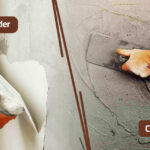
Gypsum boards, known as drywall or plasterboard, have become essential to modern architecture, transforming how we build and design structures. These adaptable panels, made of a gypsum core wrapped in a strong paper face, provide a lightweight, long-lasting, and cost-effective option for interior walls and ceilings. Gypsum boards have various advantages, including, fire resistance, acoustic insulation, and environmental sustainability. As a result, they are widely employed in residential, commercial, and industrial projects, influencing contemporary architectural practices and improving the usefulness and beauty of modern buildings. Gypcore is a Premium Gypsum Board Manufacturer in Oman known for producing high-quality, durable gypsum boards that are widely used in construction and interior design.
What is Gypsum Board?
In contemporary architecture and design, gypsum board is frequently utilized. It is made up of two sheets of paper or fiberglass laminated over a core of gypsum, a naturally occurring mineral known for its strong fire resistance. To accommodate a variety of uses, this adjustable panel comes in multiple sizes and varieties, such as standard, soundproof, fireproof, moisture-resistant, and flexible alternatives. The building industry uses gypsum board because it’s simple to install, produces a smooth finish, and can be tailored to fit a range of architectural specification
The Role of Gypsum Boards in Modern Architecture
Gypsum Board is widely used in various applications. Here are some uses of Gypsum Board:
Residential Construction: Gypsum board is the common material for building interior walls and ceilings in homes. Its flat surface is great for painting and wallpapering.
Commercial Buildings: Offices, retail stores, and other commercial areas utilize gypsum board for partition walls and ceilings because it is simple to install and inexpensive.
Industrial Buildings: Gypsum board is used in factories and warehouses to finish interiors and build fire-resistant walls.
Firewalls: The Gypsum board’s inherent fire-resistant properties make it suitable for constructing firewalls and barriers in buildings.
Wall Finishes: It provides a smooth and uniform surface for decorative finishes, including textured paints and wallpapers.
Gypsum board is a highly adaptable material that is widely used in residential, commercial, and industrial construction to build interior walls and ceilings. Its applications include fire resistance, sound insulation, moisture resistance, and decorative treatments, making it a key component in modern building methods. Drywalls for interior works in India and Oman are essential for creating smooth, durable, and aesthetically pleasing walls and ceilings in residential and commercial buildings.




